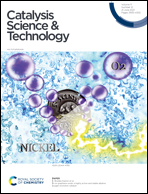Short-channel mesoporous SBA-15 silica modified by aluminum grafting as a support for CoRu Fischer–Tropsch synthesis catalysts†
Abstract
Highly ordered short-channel mesoporous silica SBA-15 with large pores (11.2 nm) has been synthesized by using tetramethyl orthosilicate (TMOS) as a silica source, the amphiphilic block copolymer Pluronic PE-10400 as a structure-directing agent, and 1,3,5-triisopropylbenzene as a swelling agent. The Al-SBA-15 support was prepared by multiple cycles of grafting of Al sec-butoxide dissolved in toluene on the calcined SBA-15 material, aiming at covering the channel surface with a subnanometric layer of Al–O chemical species. Both the pristine and the Al-containing materials have been used as supports for preparing 20 wt% Co catalysts promoted with 1 wt% Ru and then evaluated for Fischer–Tropsch synthesis (FTS). The samples have been characterized by ICP-OES, elemental analysis, N2 physisorption, XRD, electron microscopy, FTIR-pyridine, H2-TPR, H2 chemisorption, and XPS. The ordered mesopore architecture of the starting support was preserved during the grafting treatment, but the pore size was reduced from 11.2 to 10.0 nm, while the pore volume and surface area also decreased. No segregated alumina phase was detected. It was found that the Al-grafting remarkably improves the Co dispersion and favors a more homogeneous distribution of the metal species along the SBA-15 particles. Under conventional FTS conditions (220 °C, 2.0 MPa, H2/CO = 2), the Al-grafted CoRu/Al-SBA-15 catalyst exhibited a lower TOF for the exposed Co0 sites resulting in a lower CO conversion and cobalt-time-yield (CTY) with respect to the all-silica CoRu/SBA-15 counterpart. However, CoRu/Al-SBA-15 displayed, at constant CO conversion (∼40%), an enhanced selectivity to liquid hydrocarbons (C5–C20) to the detriment of waxes (C21+). While the lower activity of CoRu/Al-SBA-15 was mainly ascribed to a greater abundance of very small (<6 nm) Co0 nanoparticles with a lower TOF, the shift in selectivity towards lighter hydrocarbons was related, in addition to the contribution of sub-6 nm Co0 particles, to an enhanced CO diffusion limitation and to the cracking of long-chain FTS products on the Brønsted acid sites present in this catalyst.



 Please wait while we load your content...
Please wait while we load your content...